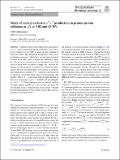Study of central exclusive production in proton-proton collisions at $$\sqrt{s} = 5.02$$s=5.02 and 13TeV
Author(s)
Sirunyan, A. M; Tumasyan, A.; Adam, W.; Ambrogi, F.; Bergauer, T.; Brandstetter, J.; Dragicevic, M.; Erö, J.; Del Valle, A. E; Flechl, M.; Frühwirth, R.; Jeitler, M.; Krammer, N.; Krätschmer, I.; Liko, D.; Madlener, T.; Mikulec, I.; Rad, N.; Schieck, J.; Schöfbeck, R.; ... Show more Show less
Download10052_2020_Article_8166.pdf (1.531Mb)
Publisher with Creative Commons License
Publisher with Creative Commons License
Creative Commons Attribution
Terms of use
Metadata
Show full item recordAbstract
Abstract
Central exclusive and semiexclusive production of pairs is measured with the CMS detector in proton-proton collisions at the LHC at center-of-mass energies of 5.02 and 13TeV. The theoretical description of these nonperturbative processes, which have not yet been measured in detail at the LHC, poses a significant challenge to models. The two pions are measured and identified in the CMS silicon tracker based on specific energy loss, whereas the absence of other particles is ensured by calorimeter information. The total and differential cross sections of exclusive and semiexclusive central production are measured as functions of invariant mass, transverse momentum, and rapidity of the system in the fiducial region defined as transverse momentum and pseudorapidity . The production cross sections for the four resonant channels
, ,
, and
are extracted using a simple model. These results represent the first measurement of this process at the LHC collision energies of 5.02 and 13TeV.
Date issued
2020-08-10Department
Massachusetts Institute of Technology. Department of PhysicsPublisher
Springer Berlin Heidelberg
Citation
The European Physical Journal C. 2020 Aug 10;80(8):718
Version: Final published version